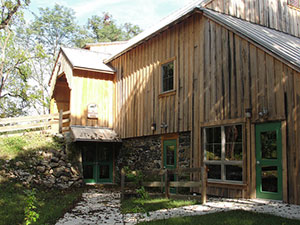Supporting Sustainability through Education and Renovations: The Brandywine Valley Association
Since 1945 the Brandywine Valley Association (BVA), headquartered at the Myrick Conservation Center in Pocopson Township, has been working to promote the restoration, preservation, and conservation of natural resources in the Brandywine Valley. As one of the oldest watershed associations in the country, the BVA has made a longstanding commitment to educating Brandywine Valley residents about the importance of their watershed and ways they can help protect it so that future generations may continue to enjoy its many benefits — both in beauty and functionality. The BVA also supports sustainability in the region through their education outreach, as well as through business practices.

Environmental Education Programs
Each year over 13,000 students throughout the Brandywine Valley reap the benefits of the BVA's Environmental Education Programs. Targeted participants include area schools, scout groups and private groups, such as home-school students. Programs are categorized by age group, ranging from elementary through high school levels, and each complies with one or more of the Pennsylvania Academic Standards for Science and Technology, or Environment and Ecology thereby adding further incentive for teachers to utilize the programs.
The BVA's Environmental Education Programs allow students to learn about a variety of environmentally-based issues through hands-on experience — something that is rarely attainable in a traditional classroom setting. Programs are hosted at outdoor classroom sites at either the BVA's Myrick Conservation Center or Saalbach Farm, on the grounds of the participating school, or at another off-site natural area such as the Stroud Preserve or Shamona Creek Park. For a more adventurous option, canoe trips along the Brandywine Creek are also available.
Sustainable Practices
In terms of sustainability, the Environmental Education Programs are noteworthy because they teach children about both the environmental and historical significance of the Brandywine watershed. Thanks to the BVA, students have the opportunity to learn about how our watershed works, its importance to our region and its many habitats, and how they can become stewards of our land and waterways in hopes of protecting it for all living things in the future.
Although programs are held outdoors whenever possible, the home base for the Environmental Education Programs is the Browning Barn, located at the Myrick Conservation Center. The barn, built in 1806, has recently undergone its first phase of renovations in order to improve its usability and overall sustainability.
 Perhaps the greatest improvement to the barn is its new insulation and weather-proofing. The barn lacked insulation and proper protection against the elements, making it a less-than-ideal home for the education program's students and materials. To solve this dilemma, insulation was added to the exterior of the existing structure and a new wooden shell was built around it. A new metal roof was added as well, along with a number of large windows and doors, and motion-sensor lighting in each room.
Perhaps the greatest improvement to the barn is its new insulation and weather-proofing. The barn lacked insulation and proper protection against the elements, making it a less-than-ideal home for the education program's students and materials. To solve this dilemma, insulation was added to the exterior of the existing structure and a new wooden shell was built around it. A new metal roof was added as well, along with a number of large windows and doors, and motion-sensor lighting in each room.
Typical of buildings that are over 200 years old, engineers found that the barn had settled a bit over time, so metal reinforcements were added to improve the general safety and longevity of the barn. Likewise, some of the wooden beams on the interior had begun to rot and were replaced with new ones. Another new interior feature is the composting toilets, which produce humanure that is then used to fertilize the BVA's agricultural fields.
All of these additions or replacements were done with sustainability in mind, with the goal of maintaining the structural and historical integrity of the barn as much as the BVA's budget and resources allowed. Recycled, locally-sourced wood was used when possible, and many of the barn's features serve not only in functionality, but also as a visual tool for educating students about how old buildings can be retrofitted to be more sustainable. The changes made in Phase I work in unison to make the Browning Barn a safe and comfortable headquarters for the Environmental Education Programs and its students, and to maintain the integrity and durability of one of Chester County's most unique historical structures. The renovations also serve as a testament to the fact that the BVA does indeed practice what they preach!
Learn More
If you are interested in learning more about the Brandywine Valley Association's Environmental Education Programs for your school or group, please visit their website, or contact the BVA's Education Director, Giselle Cosentino. Stay tuned for more information about Phase II of the Browning Barn's renovations and other exciting sustainability initiatives at the BVA.

